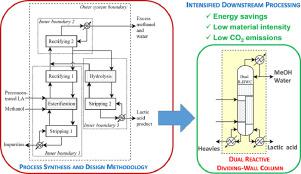Chemical Engineering and Processing: Process Intensification ( IF 3.8 ) Pub Date : 2021-04-02 , DOI: 10.1016/j.cep.2021.108402 Isabel Pazmiño-Mayorga , Megan Jobson , Anton A. Kiss

|
Methodologies for designing intensified processing units are necessary to enable the industrial application of process intensification concepts. This article presents a ruled-based systematic methodology for the synthesis and conceptual design of a dual reactive dividing wall column (dual R-DWC). A decomposition approach is used to identify the tasks required for the separation by introducing a reactive separating agent to exploit a reversible reaction to enhance the driving forces. A combination of shortcut and rigorous simulations led to the conceptual design of a novel dual R-DWC in which the forward and reverse reactions and the separation occur at once.
The methodology was demonstrated in a case study for the separation of lactic acid from dilute aqueous streams and a reactive impurity that hinders the lactic acid conversion and its recovery, while the byproducts may bring new challenges for the desired separations.
This study is the first to investigate the effect of reactive impurities on the reaction and the separation, hence adding a more realistic framework to the design. The flowsheet produced was evaluated against benchmark processes and showed a significant process improvement in terms of energy savings (ranging 13-27 %), material intensity (28-32 % reduction), and water consumption (22-36 % reduction), while the reactive impurities are effectively removed.
中文翻译:

用于乳酸下游加工的双反应性分隔壁塔的概念设计
设计强化处理单元的方法对于实现过程强化概念的工业应用是必不可少的。本文提出了一种基于规则的系统方法,用于双反应性分隔壁塔(双R-DWC)的合成和概念设计。分解方法用于通过引入反应性分离剂来利用可逆反应来增强驱动力,从而确定分离所需的任务。快捷模拟和严格模拟的结合导致了新颖的双重R-DWC的概念设计,其中正反反应和分离立即发生。
在案例研究中证明了该方法的可行性,该方法用于从稀水流中分离乳酸和阻碍乳酸转化及其回收的反应性杂质,而副产物可能为所需分离带来新的挑战。
这项研究是第一个研究反应性杂质对反应和分离的影响的研究,因此为设计增加了一个更现实的框架。对照基准流程对生产的流程进行了评估,结果表明,该流程在节能(13-27%),材料强度(减少28-32%)和水消耗(减少22-36%)方面有显着改善。有效去除杂质。











































 京公网安备 11010802027423号
京公网安备 11010802027423号